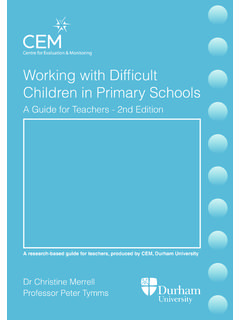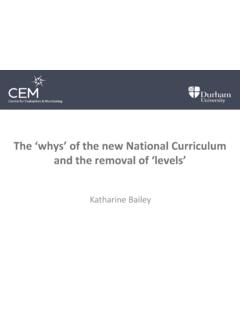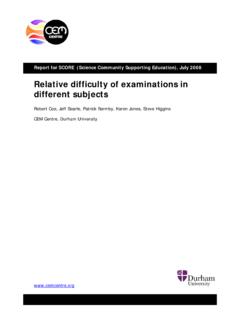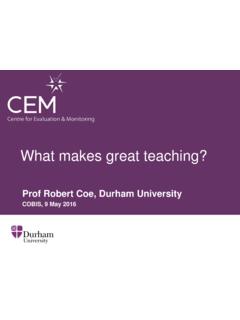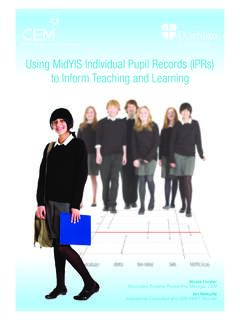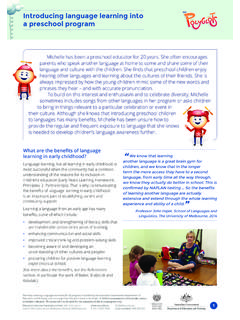Transcription of Toolkit Summary final - CEM
1 Toolkit of Strategies to Improve Learning Summary for Schools Spending the Pupil Premium By Professor Steve Higgins, Durham University Dr Dimitra Kokotsaki and Professor Robert Coe, CEM Centre, Durham University May 2011 2 Toolkit to improve learning The aim of the Government s new Pupil Premium is to raise achievement among disadvantaged children1. It will provide additional funding for disadvantaged pupils to ensure they benefit from the same educational opportunities as pupils from wealthier families. Although the precise mechanism for allocation and evaluation is still being finalised, the amount per pupil has been announced initially as 430 for 2011/12, then perhaps rising to as much as 1750 by 2014/15.
2 The Pupil Premium has a number of wider aims: to increase social mobility; to enable more pupils from disadvantaged backgrounds to get to the top Universities; to reduce the attainment gap between the highest and lowest achieving pupils nationally. Simply spending more on children from less affluent backgrounds, however, will not necessarily improve their learning or their aspirations. There is no direct link between spending on schools and outcomes for pupils. Extensive research in this area shows that it is a complex issue, indicating that the way the money is spent is crucial. So if the Pupil Premium is to succeed in achieving its ambitious goals, the choices that schools make in allocating the money will be vital so that the funding can help raise pupils attainment and aspirations.
3 The aim of this document is therefore to summarise some of the research evidence on improving learning and attainment to help schools to make more informed choices about how to support their pupils who are eligible for the additional funding. In each area we have identified different approaches to improving learning in schools, and identified the strength of the existing research evidence and then made an estimate of the costs of adopting the approaches. The Toolkit also provides guidance on whether the approaches are applicable to primary or secondary school settings, and in which core subjects English, maths or science. Applying this knowledge in schools about each approach, to ensure that the impact of any changes benefits pupils attainment will still be challenging, as there is no simple solution or guaranteed bet.
4 The aim of the Toolkit is to encourage schools and teachers to make their own informed choices and adopt a more evidence based approach: they will need to monitor the effect of their chosen approach and evaluate the investment to ensure it is having the desired effect. We also present a short Summary and an outline of what we see as the relative bene fit of the different approaches. Two appendices indicate the approximate levels of additional funding a school is likely to receive initially according to its size and the 1 For the latest Government guidance on the Pupil Premium, see: premium- what - you - need- to- know 3 percentage of pupils receiving free school meals (Appendix 1).
5 430 is about equivalent to two full days of additional teacher time per pupil per year, or a bit less than a month of a teacher s full and undivided attention over the course of their school career. If the Pupil Premium is increased to about 1750 by 2014/15 this is nearer eight days of teacher time per year or nearer four months total schooling (Appendix 2). The challenge is to use this effectively to support improved educational outcomes for these learners. Finally, we should point out that it is always challenging to apply the findings of educational research from one context to another. However our aim is to help schools to identify potentially productive strategies and approaches which they will then need to develop and evaluate to suit their own setting and context.
6 Spending for learning: linking resources and learning outcomes The challenge to establish a clear link between educational expenditure and pupils learning is harder than you would think. It may seem obvious that more money offers the possibilities for a better or higher quality educational experience, but the evidence suggests that it is not simply a question of spending more to get better results. This may be because in the UK and other developed countries we broadly spend reasonably efficiently and increased effectiveness comes at much greater cost. Much of the early research in this area failed to find a convincing connection. More recent research suggests that there is a link between spending and outcomes, but that it is a complex picture.
7 Investing in better learning, or spending for learning , is therefore not easy, particularly when the aim is to support disadvantaged learners. Much depends on the context, the school, the teachers (their levels of knowledge and experience), the learners (their level of attainment and their social background) and the educational outcomes that you want to improve (knowledge, skills or dispositions). Improving test scores in arithmetic in the short term, for example, may not raise students aspirations for what further learning in mathematics may accomplish for them. Though there is not clear evidence of the link between additional spending and learning, we interpret this to mean that it is difficult to spend additional resource effectively.
8 On average it may be hard to find a link, but there must be some areas which offer a better bet than others, and this is what this Toolkit shows. We are also not suggesting that all educational aims and outcomes are captured in the literature that we have pulled together. Most of the measures are traditional measures of attainment, curriculum tests and examinations or standardised measures. Some studies include assessment of attitudes and beliefs, but even these may have a specific focus in the studies, depending on the research aims. The rationale for inclusion and evaluation is presented in Appendix 3, with full details in the technical report which accompanies the Toolkit .
9 4 Our solution to the challenge of linking spending with learning is to focus on what the evidence indicates is effective in improving teaching and learning using typical measures, and then working out what additional costs are associated with these approaches, so as to highlight the issues for schools to explore. A number of other, less effective approaches have been included as a comparison or where they are better known to provide a reference point. The summaries combine evidence from a range of different research studies. In all cases there is a range of effects which have been combined into a single average for each area. We are not claiming that this will necessarily be the impact when schools try them out.
10 Some of the approaches which are less effective on average, might be effective in a new setting or if developed in a new way. Similarly an approach which tends to be more effective, on average, may not work so well in a new context. However we think that this evidence will be useful to schools in making a good bet on what might be valuable, or may strike a note of caution when trying out something which has not worked so well in the past. The Toolkit purposefully compares broad approaches against one another, rather than advocating specific schemes, although we hope in time to develop a number of links to specific resources for teachers to explore further, and make their own choices.
